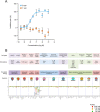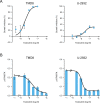Investigation of the anti-tumor mechanism of tirabrutinib, a highly selective Bruton's tyrosine kinase inhibitor, by phosphoproteomics and transcriptomics
- PMID: 36897912
- PMCID: PMC10004634
- DOI: 10.1371/journal.pone.0282166
Investigation of the anti-tumor mechanism of tirabrutinib, a highly selective Bruton's tyrosine kinase inhibitor, by phosphoproteomics and transcriptomics
Abstract
Tirabrutinib is a highly selective Bruton's tyrosine kinase (BTK) inhibitor used to treat hematological malignancies. We analyzed the anti-tumor mechanism of tirabrutinib using phosphoproteomic and transcriptomic methods. It is important to check the drug's selectivity against off-target proteins to understand the anti-tumor mechanism based on the on-target drug effect. Tirabrutinib's selectivity was evaluated by biochemical kinase profiling assays, peripheral blood mononuclear cell stimulation assays, and the BioMAP system. Next, in vitro and in vivo analyses of the anti-tumor mechanisms were conducted in activated B-cell-like diffuse large B-cell lymphoma (ABC-DLBCL) cells followed by phosphoproteomic and transcriptomic analyses. In vitro kinase assays showed that, compared with ibrutinib, tirabrutinib and other second-generation BTK inhibitors demonstrated a highly selective kinase profile. Data from in vitro cellular systems showed that tirabrutinib selectively affected B-cells. Tirabrutinib inhibited the cell growth of both TMD8 and U-2932 cells in correlation with the inhibition of BTK autophosphorylation. Phosphoproteomic analysis revealed the downregulation of ERK and AKT pathways in TMD8. In the TMD8 subcutaneous xenograft model, tirabrutinib showed a dose-dependent anti-tumor effect. Transcriptomic analysis indicated that IRF4 gene expression signatures had decreased in the tirabrutinib groups. In conclusion, tirabrutinib exerted an anti-tumor effect by regulating multiple BTK downstream signaling proteins, such as NF-κB, AKT, and ERK, in ABC-DLBCL.
Copyright: © 2023 Kozaki et al. This is an open access article distributed under the terms of the Creative Commons Attribution License, which permits unrestricted use, distribution, and reproduction in any medium, provided the original author and source are credited.
Conflict of interest statement
This study was funded by Ono Pharmaceutical Co., Ltd. (Osaka, Japan). All authors are employees of Ono Pharmaceutical Co., Ltd. Some of the authors are inventors of patents filed by Ono Pharmaceutical Co., Ltd. in relation to this work: WO2015/067586 (“Combination therapy of an afucosylated CD20 antibody with a BTK inhibitor”, Tomoko Yasuhiro); WO2015/146159 (“Prophylactic agent and/or therapeutic agent for diffuse large B-cell lymphoma”, Ryohei Kozaki); WO2016/209961 (“Combination therapies for treating B cell malignancies”, Tomoko Yasuhiro and Ryohei Kozaki); WO2017/059224 (“Combination of a BTK inhibitor and a checkpoint inhibitor for treating cancers”, Tomoko Yasuhiro); and WO2019/208805 (“Preventive and/or therapeutic agent for autoimmune disease comprising compound having BTK inhibitory activity as active ingredient”, Yuko Ariza).
Figures






References
Publication types
MeSH terms
Substances
LinkOut - more resources
Full Text Sources
Molecular Biology Databases
Miscellaneous

